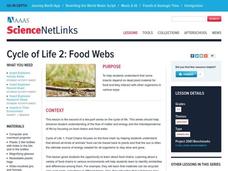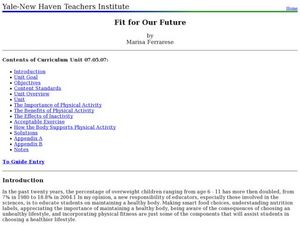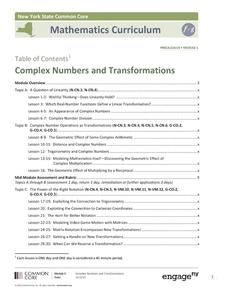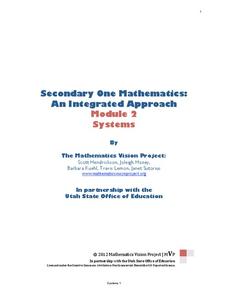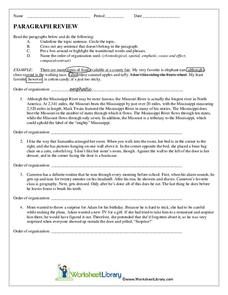Curated OER
Social Studies: Grab Day at the Pueblo
Pupils develop a cultural understanding of "Grab Day." Using magazines, they clip out pictures to make collages of items thrown down to people on this day. Students label the items in their collages.
Curated OER
Create a Habitat for an Animal
In this marine life learning exercise, students label the ocean animal and each part of its habitat. Students then draw one of the habitats including the animals and plants that live there.
Curated OER
Going On A Picnic
Students classify items you would bring on a picnic into different categories. In this sorting lesson plan, students have categories of food, table things, and toys. A simple lesson that teaches an important skill.
Curated OER
Land Use Issues
Students discover seeds are a source of life. They also label the parts of a seed and examine the conditions which are needed for the seed to start growing. They follow the life cycle of seeds.
Curated OER
All Wrapped Up
Pupils work in teams to identify and sort types of packaging used in food production. They consider ways to reduce the environmental impact of packaging and reflect how consumer choices play a role in trash production.
Curated OER
Allele Frequencies and Sickle Cell Anemia Lab
Students investigate how selective forces like food, predation and diseases affect evolution. In this genetics lesson, students use red and white beans to simulate the effect of malaria on allele frequencies. They analyze data collected...
Curated OER
Being Thankful
Students generate words and pictures to show their thankfulness. In this Thanksgiving art lesson, students draw various circles, labeling and illustrating the things for which they are grateful.
BBC
Global Community: T-Shirt Activity
Examine fair trade and the impacts it has on the global community. Kids consider how t-shirts are made, where they come from, and how fair trade works. They design t-shirts that describe the affects of fair trade on various populations...
Biology Junction
Macromolecules
In chemistry, organic means something contains a carbon base. A helpful presentation starts by defining macromolecules as large organic carbon molecules. Scholars answer questions about each topic on the associated worksheet. It covers...
Curated OER
Where Are the Dinosaurs?
Students examine the concept of extinction by studying dinosaurs. For this living environment lesson, students view dinosaur video clips and define the word "extinction." Students visit the "Zoom Dinosaur" website to investigate various...
Curated OER
Getting Real: Using Real Life Materials
Students examine many different types of real-life materials such as menus or newspaper articles. They practice filling out job applications or ordering at a sitdown restaurant.
Curated OER
Fit for Our Future
Learners understand the importance of physical fitness as part of a healthy lifestyle. In this health lesson students create a display and presentation about what they learned.
IBM
The Human Body
Every moment, the systems in your body are working together to keep you breathing, standing, and thinking. Elementary schoolers explore the human body and its systems with an impressive, 15-page lesson plan that should leave your...
Curated OER
Water Works
Students create a "water web" to illustrate the interdependence among water users and producers. They distinguish between direct and indirect uses of water; illustrate the interconnectedness of water users in a community; and demonstrate...
Curated OER
Human Body Lessons
Students read "The Magic School Bus in the Human Body" and discuss the importance of maintaining a healthy body. They create a hinge and joint paper skeleton, follow the journey of a hamburger through the digestive tract, jump rope and...
Curated OER
Microbes
Microbiology beginners feed different sweetening agents to yeast and measure carbon dioxide production to estimate energy contained in each. They set the trials up in zip-top plastic baggies and then measure gas volume by water...
Curated OER
Quinoa Pasta 3
A mixture of quinoa and corn is for dinner in this collaborative task that sets up nicely as a system of linear equations. Your supper guests discuss numerical precision and percentages as they formulate a plan of how to solve the problem.
EngageNY
Complex Numbers and Transformations
Your learners combine their knowledge of real and imaginary numbers and matrices in an activity containing thirty lessons, two assessments (mid-module and end module), and their corresponding rubrics. Centered on complex numbers and...
Perkins School for the Blind
Polyatomic Ion Bingo
If your class is learning about polyatomic ions and needs a fun way to study those chemicals, then a bingo game might be right up your alley. This bingo game is intended to boost memorization skills, specifically the names of tricky...
Inside Mathematics
Number Towers
Number towers use addition or multiplication to ensure each level is equal. While this is common in factoring, it is often not used with algebraic equations. Solving these six questions relies on problem solving skills and being able to...
ARKive
Plants
Here is a one-hour activity that helps learners remember the parts of plants. Not only will the class learn about plant parts, they'll also discuss seed dispersal and plant growth. A celery experiment is used to show how plants obtain...
Mathematics Vision Project
Module 2: Systems of Equations and Inequalities
The brother-sister pair Carlos and Clarita need your class's help in developing their new pet sitting business. Through a variety of scenarios and concerns presented to the siblings, the learners thoroughly explore systems of equations...
Grand Erie District School Board
Model Cell Project
If you're finishing up a unit on cells, here's a great project to get kids collaborating and recalling what they've learned in a fun and tangible way. Small groups create plant or animal cells out of materials they have at home. They use...
Curated OER
Paragraph Review
Use a worksheet to help learners identify the topic sentence and transitional words. They eliminate sentences that do not belong in the paragraph and name the pattern of organization used. Great for homework or extra credit.











